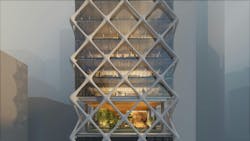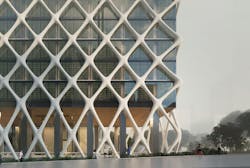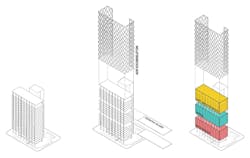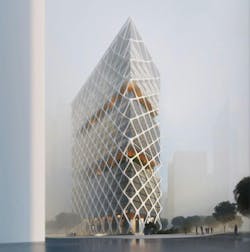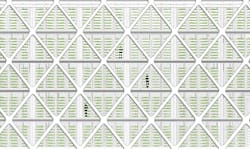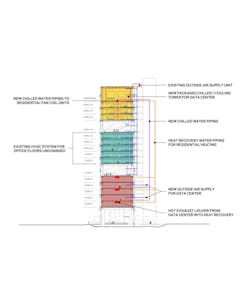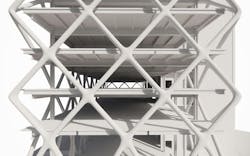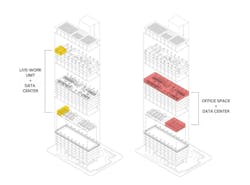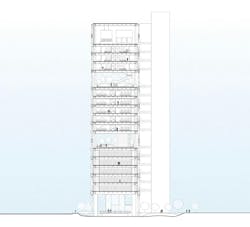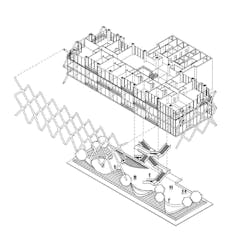Transforming office towers into AI hubs and urban data centers
Cities around the world continue to struggle with downtown office vacancies brought on by the pandemic and the shift to hybrid and remote work. This has been especially pronounced in San Francisco where the city’s tech-based economy made it easy for workers to shift from the corporate office to home office.
To date, the most common solution for empty or half-filled office towers is to convert them to residential use. Yet not all office buildings make for ideal residential conversion. What might be done with those buildings? Could they be adapted for novel and new uses?
These are questions a San Francisco team of HOK designers and engineers recently explored. Their hypothetical study imagined transforming office towers into next-generation innovation hubs—ones that could advance AI computing, reuse energy for urban agriculture and add new vibrancy to downtown office districts.
While not every concept presented here may be realized today, the study provides a visionary look at how cities like San Francisco could adapt existing building stock for inventive new uses.
Let’s explore…
Computing Speed: The New Amenity
The value of office buildings today hinges on their tenant amenities. Class A properties with the best amenities continue to maintain strong occupancy and lease rates.
Yet beyond the typical hospitality-focused amenities, such as fitness centers, indoor/outdoor social spaces and on-site catering, what would be an appealing amenity for companies on the leading edge of computing technology?
Access to (and control of) an on-site data server could be a true difference maker for companies in the fintech, banking and gaming industries. This “digital amenity” would provide tenants with greater processing speed, security and customization than their competitors located elsewhere.
For these companies, latency and lag associated with cloud computing can have a real impact on their products and services. This is especially true as increasing wireless services and the emergence of large language models (and other artificial intelligence) are placing ever-greater demands on cloud computing.
Edge data centers located within urban cores can help alleviate some of the latency associated with accessing larger, regional data centers on the cloud. An opportunity now exists to bring data connection even closer—literally within arm’s reach of the programmers, data scientists and computer engineers spearheading today’s advanced technology.
Direct liquid cooling (DLC) servers require only a third of the space of traditional air-cooled data centers. These compact servers can easily fit within a high-rise tower instead of the warehouse-type facilities that typically house data centers. Moving data centers on site would give tenants faster connections and greater customization than ever before.
One caveat to bringing data centers on site, however, is the question of heat. While DLC servers are more efficient than air-cooled servers, they still generate significant amounts of heat. Could this heat be used for other purposes, say hydroponic farming?
Green Technology: Vertical Farming + MEP Systems
Co-locating data centers with hydroponic farming could allow for a symbiotic recycling of resources. Agriculture requires warm, stable temperatures. Excess heat from the liquid-cooled server racks could be channeled through a building’s heat exchange system and delivered to agricultural floors.
Condensate from the DLC server’s closed-loop cooling systems could be harvested for crop irrigation. Repurposing heat and condensate for urban agriculture would help mitigate the environmental impact and financial costs of operating an on-site data center.
The addition of on-site server systems and agriculture would likely require updates to a building’s mechanical, electric and plumbing (MEP) systems. Adding cooling towers to the building could help reduce up to 70% of the heat output generated from the data centers. Air ventilation and computer room air handler (CRAH) units also could provide supplemental cooling and ventilation.
Office floors within the building could be serviced by a heat recovery chiller that routes heat from the data centers to areas of the building that need heating. During warmer months, the heat captured by the servers’ liquid-cooling system could be routed to the condenser loop and cooling towers.
Retrofitting existing office buildings in San Francisco for mixed-use purposes would require mandatory seismic upgrades. This provides the opportunity for a dynamic, expressive external structure as documented in the images for this report.
The proposed approach involves a new diagrid, made from steel tubes welded to custom-cast steel nodes at all intersections. In addition to the external bracing system, existing columns, beams and connections within the building would need to be strengthened to accommodate the new servers.
A New Office Leasing Strategy
Most existing office buildings feature expansive floorplates intended to house a single client per floor (and often a single client over multiple floors). While this design worked for much of the past, today’s office tenants are looking for smaller floorplates with greater flexibility and more work setting options.
In addition to bringing data centers and agriculture into the building, owners might also reimagine the way they lease and fit out workplace units. Office leases could come with access to (or ownership of) certain servers within the on-site data center.
Tenants also could choose between a combination of traditional office space or live-work units. Inspired by the small apartment-like “officetels” in Asia and designed to appeal to startups, live-work units could include private kitchens and restrooms and multiple configurations in size and layout. Tenants in the live-work units also could have use of servers in the data centers.
A cutout skygarden (below) linking the live-work units with the office floors could create a dynamic space for tenant collaboration, socialization and well-being.
Adaptable Buildings for Adaptable Cities
The evolving landscape of commercial real estate in urban centers presents opportunities for office building owners to adapt to the changing demands of the tech industry. By embracing innovative design concepts, integrating data center capabilities and prioritizing sustainability, building owners can enhance the value and functionality of their properties. This forward-thinking approach not only meets the needs of AI-focused industries but also contributes to the revitalization of urban cores and the creation of dynamic, technology-driven work environments.
Let’s Connect
Want to know more about this study? Contact Peter Choi, AIA, Principal-Design for HOK’s San Francisco studio.
